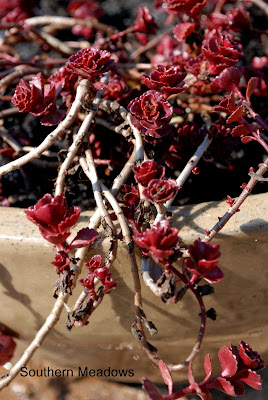Dragon's Blood & The Bees
Last week Donna at Garden's Eye View did a post on one of her favorite plants, Columbine. Donna has an incredible selection of Columbine and I encourage you to check out her beautiful post. As part of the Project Save the Bees Donna did a seed give away asking gardener's to name their favorite pollinator plant. My answer to this question was Sedum. I have several varieties of Sedum in my garden and they are always covered in bees when they are in their summer bloom. To my delight, I won some seeds! I've never won seeds before so I am really looking forward to receiving them and I will do a full post on them when I get them planted and growing. In the meantime, I thought I would do a post on one of the Sedum I have in my garden...Sedum spurium Dragon's Blood stonecrop.
I am fascinated by plant's names and Dragon's Blood is such a great one! It just seems like something from another time. It makes me think of sorcerers, dragons and wizardry. Maybe something magical and mysterious going on in the garden. The word sedum is from Latin "to sit" and stonecrop refers to their seeming ability to grow out of stone. Stonecrop make great ground cover plants, often seen in rock gardens.
Whereas it makes a spectacular ground cover it can be invasive as it spreads easily. I have mine in a pot where it can spill over the edge. This keeps it protected from the dogs and the kids who tend to run through the flower beds sometimes rather unobservant of where they are trotting. This pot sits on an old tree stump where it gets full sun and compliments the spring blooms of the azaleas and knock-out roses that surround it.
The blooms that adorn the Dragon's Blood in the summer months are covered with pollinators. The decline in the honey bee population has been in the news lately. As gardeners we need to keep on gardening to provide our local honey bees with the nectar and pollen they can collect from flowers in our gardens. Blake Layton, Extension Entomology Specialist at Mississippi State University in his recent article The Trouble with Honey Bees published in Georgia Gardening Magazine, recommends limiting our use of insecticides. Don't spray unless all other alternatives have failed. If you need to spray treat at a time when foraging bees are not present which is at dusk after the bees have returned to the hive for the night. If you are interested in reading more about gardening for bees Audubon Magazine has an article about incorporating flowering plants and vegetables into your landscape to help your local bees.
I am fascinated by plant's names and Dragon's Blood is such a great one! It just seems like something from another time. It makes me think of sorcerers, dragons and wizardry. Maybe something magical and mysterious going on in the garden. The word sedum is from Latin "to sit" and stonecrop refers to their seeming ability to grow out of stone. Stonecrop make great ground cover plants, often seen in rock gardens.
I am captivated by plants that provide great blooms and fabulous foliage. The ruby-red star flowers are stunning and the purple leaves that come on later in the spring are splendid. It has a great pink blooms in the summer time which the bees and butterflies love. These are all shots I took in the garden yesterday. You can see that even in my zone (7b) it provides interest all year round and is also rabbit and deer-resistant as well as a drought tolerant plant.
Whereas it makes a spectacular ground cover it can be invasive as it spreads easily. I have mine in a pot where it can spill over the edge. This keeps it protected from the dogs and the kids who tend to run through the flower beds sometimes rather unobservant of where they are trotting. This pot sits on an old tree stump where it gets full sun and compliments the spring blooms of the azaleas and knock-out roses that surround it.
The blooms that adorn the Dragon's Blood in the summer months are covered with pollinators. The decline in the honey bee population has been in the news lately. As gardeners we need to keep on gardening to provide our local honey bees with the nectar and pollen they can collect from flowers in our gardens. Blake Layton, Extension Entomology Specialist at Mississippi State University in his recent article The Trouble with Honey Bees published in Georgia Gardening Magazine, recommends limiting our use of insecticides. Don't spray unless all other alternatives have failed. If you need to spray treat at a time when foraging bees are not present which is at dusk after the bees have returned to the hive for the night. If you are interested in reading more about gardening for bees Audubon Magazine has an article about incorporating flowering plants and vegetables into your landscape to help your local bees.




.png)
